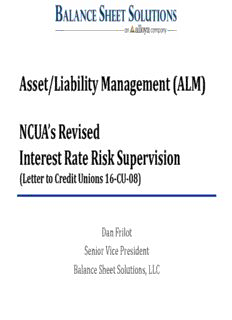
(ALM) NCUA's Revised Interest Rate Risk Supervision PDF
Preview (ALM) NCUA's Revised Interest Rate Risk Supervision
Asset/Liability Management (ALM) NCUA’s Revised Interest Rate Risk Supervision (Letter to Credit Unions 16-CU-08) Dan Frilot Senior Vice President Balance Sheet Solutions, LLC Background Balance Sheet Solutions, LLC (BSS) Founded in 2002 and is wholly owned by Alloya Corporate Federal Credit Union. Our staff averages 26 years of experience in institutional financial services and 13 years specifically working with and for credit unions. We help over 800 credit unions in the U.S. with balance sheet strategy, investment execution, and risk measurement. Dan Frilot, SVP - ALM Risk Management Experience: Over 25 years in financial services industry, 20+ years working directly with credit unions on balance sheet management strategies including liquidity and funding, loan portfolio analytics and loan participations, interest rate risk mitigation, and concentration risk. 2 Agenda NCUA’s Letter to Credit Unions 16-CU-08 Revised Interest Rate Risk (IRR) Supervision IRR Supervision Scope & Expectations Are Interest Rates Headed Higher? 3 NCUA Letter to Credit Unions 16-CU-08 Revised Interest Rate Risk Supervision Development of the Net Economic Value (NEV) Supervisory Test Updated IRR tolerance thresholds for NEV Interest Rate Risk Review Procedures Workbook Creation of Estimated NEV Tool for Small CU’s Revision of IRR Chapter in Examiner’s Guide Effective January 1, 2017 4 NEV Supervisory Test – What Is It? Total balance sheet IRR metric Focus on capital at risk Creates uniform and consistent IRR NEV measure across all credit unions Shifts regulatory focus towards IRR outliers 5 Net Economic Value (NEV) The fair market value of assets minus the fair market value of liabilities equals NEV. NEV includes only existing balances and contracts as of the analysis date. NEV does not include projected new volumes. Market-based measurement = NEV Ratio 6 NEV Sensitivity Identify base case NEV at point in time If market interest rates rise or fall, what happens to the amount of NEV (i.e. the percentage change in NEV)? Percentage change in NEV = NEV Sensitivity 7 NEV Supervisory Test – Mechanics Examiner will use credit union’s internally-derived NEV information on assets, term share certificates, and other liabilities. 1% deposit premium benefit given to non-maturity shares (NMS) in base case. 4% benefit given to NMS (from new base) at +300 basis point rate shock scenario. NEV ratio and NEV sensitivity evaluated at +300 basis point rate shock scenario. 8 NEV Supervisory Test – Why Developed? Large percentage (over 70%) of credit union funding in non-maturity share balances. Significant uncertainty surrounding non-maturity share valuation methods. Credit unions primarily use past behavior to predict future behavior of non-maturity accounts. Technology has made it easier to shift money between financial institutions. Historical deposit regression analysis may no longer be accurate. Standardization will allow NCUA to compare risk across the CU system. 9 Average Share Balance Composition - All CUs Nationwide $180 Share Certificates $160 IRA/KEOGH Shares Share Drafts $140 Money Market $120 Regular Shares Non-Maturity Shares 81% s$100 2Q16 n o i l li $80 Non-Maturity M Shares 65% $60 4Q07 $40 $20 $0 Source: Callahan Peer-to-Peer 10
Description: